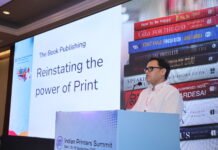The Mumbai-based Alka Publications, located at Mody Street, Fort, is among the oldest children book publishers. Alka holds over 2,500 titles in children’s books. Speaking to IPP, Manoj Lakhani, owner of Alka Publications said, “We started our business with distribution services in 1985, and then gradually got engaged in children book publishing in the year 1992. In the initial phase, a lot of children books used to be imported. However, the scenario has completely changed with times. With the introduction of latest technologies, Indian publishers have come up with their own developed content—a move that has garnered much appreciation from parents and children alike. Today, Indian published books including Alka’s are majorly exported to Africa, Middle East and Australia.”
Alka Publications has also participated in many international book fairs, and plan to have their stall at the heart of the Frankfurt Book Fair in Hall 6.1, Stall E- 75. Lakhani believes in publishing fancy books for children at economical rates. At the fair, they plan to meet potential publishers in different regions and sell copyrights or take orders for printing of children books. To maintain the interest of readers, they recently launched storybook covers with high quality graphics on Metpet substrate. Lakhani shared, “Our newly launched books are published using five color printing and drip UV effect on Metpet board. It is an in-house concept and another such 100 books will be entering the market soon. We keep on encouraging the diversity in books including their content, shape and style. The mindset of parents to gift their children with best products and providing high-quality printed books available at reasonable price will drive the demand among the readers.”
With the introduction of latest technologies, Indian publishers have come up with their own developed content—a move that has garnered much appreciation from parents and children alike.
Earlier, children’s books were published on plastic card and heavy thick boards. In India, board books— the durable, cardboard-page titles— are still prevalent but the sales in export is on the decline. “Now a days, many parents and school children come to us for getting their poems published, apart from artists. We fix a payable amount to authors and every right is retained by us. Apart from high-quality print, hole punch and perforation are some other finishing requirements in children’s books. We produce around 16 to 320 page books and use 120 gsm paper inside the book, especially for coloring books to avoid the see-through effect,” he said.
Profits may have tripled recently, but it is passion, according to Lakhani, that predominantly drives the industry—a sense of being “custodians of the best children’s content,” with a unique responsibility to create the readers of the future. “Though the print rates have drastically reduced as compared to the late ’90s, print remains alive and well in the children’s book space,” Lakhani concluded.

















